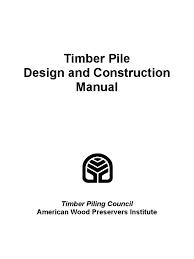كتاب Timber Pile Design and Construction Manual
Timber Pile Design and Construction Manual - Pile Driving Timber Piling Council American Wood Preservers Instituteتصميم الخوازيق فى المبانى البحرية
Piles design in the marine buildings
Timber Pile Design and Construction Manual
Table of Contents
1.0 Introduction
1.1 Scope of Manual
1.2 Background
1.3 Seismic Design Considerations
1.4 Organization of Ma
nual
2.0 Foundation Design Procedure
2.1 Design of Foundations
2.2 Foundation Design Process
3.0 Timber
Pile Properties
3.1 Introduction
3.2 Allowable Stress Design
3.3 Tabulation of Allo
wable Stress and Pile Capacity
3.3.1 Pipe Capacity
3.4 Pile Size Specifications
3.5 Working Strength bas
ed on Small Clear Wood Specimens
3.5.1 Axial Compressive Stress
3.5.2 Extreme Fiber Bending Stress
3.5.3 Compressive Stress Pe
rpendicular to the Grain
3.5.4 Shear Stress Perpendic
ular to the Grain
3.5.5 Modulus of Elasticity
3.6 Allowable Stress
3.6.1 Load Duration
3.6.2 Temperature
3.6.3 Pressure Treatment
3.6.4 Size
3.6.5 Load Sharing
3.6.6 Allowable Stress
3.7 Preservative Process
3.7.1 Creosote
3.7.2 Chromated Copper Arsenate (CCA)
3.7.2.1
CCA Industrial Uses
3.7.3 Ammoniacal Copper Zinc Arsenate (ACZA)
3.7.4 CCA and ACZA
3.7.5 Preservative Retention
3.8 Durability Considerations
4.0 Static A
nalysis Design Procedures
4.1 Introduction
4.2 Soil/Pile Interaction
4.2.1 Load Transfer
4.3 Factors of Safety
4.4 Engineering News Record Formula
5.0 Design of Single Piles
5.1 Introduction
5.2 Meyerhof Method
5.3 Nordlund Method
5.4 Alpha (
α
) Method
5.5 Effective Stress Method fo
r Piles in Cohesionless and Cohesive
Soils
5.6 Nottingham and Schmertmann Method
5.7 Uplift Capac
ity of Single Piles
6.0 Design of Pile Groups
6.1 Introduction
6.2 Axial Capacity of Pi
le Groups in Cohesionless Soils
6.3 Axial Capacity of Pile Groups in Cohesive Soils
6.4 Settlement of Pile
Groups in Cohesionless Soils
6.5 Settlement of Pile Groups in Cohesive Soils
7.0 Marine Applic
ation Design Considerations
7.1 Introduction
7.2 Broms’ Method
8.0 Pile Installation
8.1 Introduction
8.2 Pile Driving Equipment
8.2.1 Leads
8.2.2 Pile Hammers
8.2.3 Helmet
8.3 Hammer Size Selection
8.4 Pile Accessories
8.5 Pile Cutoffs
9.0 Pile Load Testing
9.1 Introduction
9.2 Axial Compre
ssion Static Load Test
9.2.1 Interpretation of Load Test
10.0 Quality Assurance During Pile Driving
10.1 Introduction
10.2 Timber Pile Q
uality Requirements
10.3 Material Certifications
10.4 Pile Driving Equipment and Pile Installation
11.0 Specifications
11.1 Introduction
11.2 Material Specification
12.0 Geotechnical Considerations
12.1 Introduction
12.2 Planning Site Investigation
12.2.1 Desk Study – Available Existing Data
12.2.2 Field Reconnaissance
12.3 Guidelines for Minimum S
ubsurface Exploration Program
12.4 Methods of Subsurface Exploration
12.4.1 Hollow-Stem Augers
12.4.2 Rotary Wash Borings
12.4.3 Test (Exploration) Pit Excavation
12.5 Soil and Rock Sampling
12.5.1 Soil Samplers
12.5.2 Rock Core Samplers
12.6 Groundwater Conditions
12.7 Subsurface Profile Development
12.8 In-Situ Testing
12.8.1 Cone Penetration Test (CPT)
12.8.2 Vane Shear Test
12.9 Laboratory Soil Testing
12.9.1 Index Tests
12.9.2 Shear Strength Tests
12.9.3 Consolidation Tests
12.10 Laboratory Testing for Pile
Driveability Determination
References
Appendix A Design Examples
..................................
-
من الهندسة المدنية - مكتبة كتب الهندسة والتكنولوجيا.

قراءة كتاب Timber Pile Design and Construction Manual أونلاين
معلومات عن كتاب Timber Pile Design and Construction Manual:
Timber Piling Council
American Wood Preservers Institute
تصميم الخوازيق فى المبانى البحرية
Piles design in the marine buildings
Timber Pile Design and Construction Manual
Table of Contents
1.0 Introduction
1.1 Scope of Manual
1.2 Background
1.3 Seismic Design Considerations
1.4 Organization of Ma
nual
2.0 Foundation Design Procedure
2.1 Design of Foundations
2.2 Foundation Design Process
3.0 Timber
Pile Properties
3.1 Introduction
3.2 Allowable Stress Design
3.3 Tabulation of Allo
wable Stress and Pile Capacity
3.3.1 Pipe Capacity
3.4 Pile Size Specifications
3.5 Working Strength bas
ed on Small Clear Wood Specimens
3.5.1 Axial Compressive Stress
3.5.2 Extreme Fiber Bending Stress
3.5.3 Compressive Stress Pe
rpendicular to the Grain
3.5.4 Shear Stress Perpendic
ular to the Grain
3.5.5 Modulus of Elasticity
3.6 Allowable Stress
3.6.1 Load Duration
3.6.2 Temperature
3.6.3 Pressure Treatment
3.6.4 Size
3.6.5 Load Sharing
3.6.6 Allowable Stress
3.7 Preservative Process
3.7.1 Creosote
3.7.2 Chromated Copper Arsenate (CCA)
3.7.2.1
CCA Industrial Uses
3.7.3 Ammoniacal Copper Zinc Arsenate (ACZA)
3.7.4 CCA and ACZA
3.7.5 Preservative Retention
3.8 Durability Considerations
4.0 Static A
nalysis Design Procedures
4.1 Introduction
4.2 Soil/Pile Interaction
4.2.1 Load Transfer
4.3 Factors of Safety
4.4 Engineering News Record Formula
5.0 Design of Single Piles
5.1 Introduction
5.2 Meyerhof Method
5.3 Nordlund Method
5.4 Alpha (
α
) Method
5.5 Effective Stress Method fo
r Piles in Cohesionless and Cohesive
Soils
5.6 Nottingham and Schmertmann Method
5.7 Uplift Capac
ity of Single Piles
6.0 Design of Pile Groups
6.1 Introduction
6.2 Axial Capacity of Pi
le Groups in Cohesionless Soils
6.3 Axial Capacity of Pile Groups in Cohesive Soils
6.4 Settlement of Pile
Groups in Cohesionless Soils
6.5 Settlement of Pile Groups in Cohesive Soils
7.0 Marine Applic
ation Design Considerations
7.1 Introduction
7.2 Broms’ Method
8.0 Pile Installation
8.1 Introduction
8.2 Pile Driving Equipment
8.2.1 Leads
8.2.2 Pile Hammers
8.2.3 Helmet
8.3 Hammer Size Selection
8.4 Pile Accessories
8.5 Pile Cutoffs
9.0 Pile Load Testing
9.1 Introduction
9.2 Axial Compre
ssion Static Load Test
9.2.1 Interpretation of Load Test
10.0 Quality Assurance During Pile Driving
10.1 Introduction
10.2 Timber Pile Q
uality Requirements
10.3 Material Certifications
10.4 Pile Driving Equipment and Pile Installation
11.0 Specifications
11.1 Introduction
11.2 Material Specification
12.0 Geotechnical Considerations
12.1 Introduction
12.2 Planning Site Investigation
12.2.1 Desk Study – Available Existing Data
12.2.2 Field Reconnaissance
12.3 Guidelines for Minimum S
ubsurface Exploration Program
12.4 Methods of Subsurface Exploration
12.4.1 Hollow-Stem Augers
12.4.2 Rotary Wash Borings
12.4.3 Test (Exploration) Pit Excavation
12.5 Soil and Rock Sampling
12.5.1 Soil Samplers
12.5.2 Rock Core Samplers
12.6 Groundwater Conditions
12.7 Subsurface Profile Development
12.8 In-Situ Testing
12.8.1 Cone Penetration Test (CPT)
12.8.2 Vane Shear Test
12.9 Laboratory Soil Testing
12.9.1 Index Tests
12.9.2 Shear Strength Tests
12.9.3 Consolidation Tests
12.10 Laboratory Testing for Pile
Driveability Determination
References
Appendix A Design Examples
..................................
عدد مرات التحميل : 15579 مرّة / مرات.
تم اضافته في : الأحد , 11 مايو 2008م.
حجم الكتاب عند التحميل : 3.8 ميجا بايت .
تعليقات ومناقشات حول الكتاب:
Timber Pile Design and Construction Manual - Pile Driving
Timber Piling Council
American Wood Preservers Institute
تصميم الخوازيق فى المبانى البحرية
Piles design in the marine buildings
Timber Pile Design and Construction Manual
Table of Contents
1.0 Introduction
1.1 Scope of Manual
1.2 Background
1.3 Seismic Design Considerations
1.4 Organization of Ma
nual
2.0 Foundation Design Procedure
2.1 Design of Foundations
2.2 Foundation Design Process
3.0 Timber
Pile Properties
3.1 Introduction
3.2 Allowable Stress Design
3.3 Tabulation of Allo
wable Stress and Pile Capacity
3.3.1 Pipe Capacity
3.4 Pile Size Specifications
3.5 Working Strength bas
ed on Small Clear Wood Specimens
3.5.1 Axial Compressive Stress
3.5.2 Extreme Fiber Bending Stress
3.5.3 Compressive Stress Pe
rpendicular to the Grain
3.5.4 Shear Stress Perpendic
ular to the Grain
3.5.5 Modulus of Elasticity
3.6 Allowable Stress
3.6.1 Load Duration
3.6.2 Temperature
3.6.3 Pressure Treatment
3.6.4 Size
3.6.5 Load Sharing
3.6.6 Allowable Stress
3.7 Preservative Process
3.7.1 Creosote
3.7.2 Chromated Copper Arsenate (CCA)
3.7.2.1
CCA Industrial Uses
3.7.3 Ammoniacal Copper Zinc Arsenate (ACZA)
3.7.4 CCA and ACZA
3.7.5 Preservative Retention
3.8 Durability Considerations
4.0 Static A
nalysis Design Procedures
4.1 Introduction
4.2 Soil/Pile Interaction
4.2.1 Load Transfer
4.3 Factors of Safety
4.4 Engineering News Record Formula
5.0 Design of Single Piles
5.1 Introduction
5.2 Meyerhof Method
5.3 Nordlund Method
5.4 Alpha (
α
) Method
5.5 Effective Stress Method fo
r Piles in Cohesionless and Cohesive
Soils
5.6 Nottingham and Schmertmann Method
5.7 Uplift Capac
ity of Single Piles
6.0 Design of Pile Groups
6.1 Introduction
6.2 Axial Capacity of Pi
le Groups in Cohesionless Soils
6.3 Axial Capacity of Pile Groups in Cohesive Soils
6.4 Settlement of Pile
Groups in Cohesionless Soils
6.5 Settlement of Pile Groups in Cohesive Soils
7.0 Marine Applic
ation Design Considerations
7.1 Introduction
7.2 Broms’ Method
8.0 Pile Installation
8.1 Introduction
8.2 Pile Driving Equipment
8.2.1 Leads
8.2.2 Pile Hammers
8.2.3 Helmet
8.3 Hammer Size Selection
8.4 Pile Accessories
8.5 Pile Cutoffs
9.0 Pile Load Testing
9.1 Introduction
9.2 Axial Compre
ssion Static Load Test
9.2.1 Interpretation of Load Test
10.0 Quality Assurance During Pile Driving
10.1 Introduction
10.2 Timber Pile Q
uality Requirements
10.3 Material Certifications
10.4 Pile Driving Equipment and Pile Installation
11.0 Specifications
11.1 Introduction
11.2 Material Specification
12.0 Geotechnical Considerations
12.1 Introduction
12.2 Planning Site Investigation
12.2.1 Desk Study – Available Existing Data
12.2.2 Field Reconnaissance
12.3 Guidelines for Minimum S
ubsurface Exploration Program
12.4 Methods of Subsurface Exploration
12.4.1 Hollow-Stem Augers
12.4.2 Rotary Wash Borings
12.4.3 Test (Exploration) Pit Excavation
12.5 Soil and Rock Sampling
12.5.1 Soil Samplers
12.5.2 Rock Core Samplers
12.6 Groundwater Conditions
12.7 Subsurface Profile Development
12.8 In-Situ Testing
12.8.1 Cone Penetration Test (CPT)
12.8.2 Vane Shear Test
12.9 Laboratory Soil Testing
12.9.1 Index Tests
12.9.2 Shear Strength Tests
12.9.3 Consolidation Tests
12.10 Laboratory Testing for Pile
Driveability Determination
References
Appendix A Design Examples
Piles design in the marine buildings
pile foundation pdf
pile foundation design example
types of piles foundation
concrete piles
driven piles
deep foundation types
deep foundation pdf
end bearing pile
 مهلاً !
مهلاً !قبل تحميل الكتاب .. يجب ان يتوفر لديكم برنامج تشغيل وقراءة ملفات pdf
يمكن تحميلة من هنا 'تحميل البرنامج'

نوع الكتاب : pdf.
اذا اعجبك الكتاب فضلاً اضغط على أعجبني و يمكنك تحميله من هنا:











